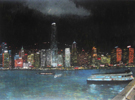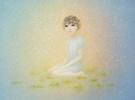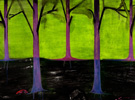What kind of an education did you receive?
It was not until I was eight years old that I started primary school. My father took me on my first day, clenching me with his left hand, and carrying a small straw stool in the other (we had to bring our own stools). The school was located in a dilapidated work shed in the eastern part of town. The windows had no panes and it was very drafty.
After entering the classroom, a female teacher took me by the hand and spoke to me softly, “Child, you are too frail. Sit here in the first row.” Half a year later, I received two textbooks—Chinese and Math. With only two textbooks to memorize, I finished primary school effortlessly with a lot of extra time to do the housework.
I did not show any particular talent in primary school. Although I was short and frail, I often got into fights with my schoolmates. When I was winning against a stronger opponent, others would join in. Later on, those much stronger opponents became my friends and we fought side by side.
I would often shoot flowers out of the trees in our yard with a slingshot and give them to girls at school. Every day after school, I would head straight for the fields, tools in hand, humming the songs and rhymes my grandmother had taught me.
In the beginning, there were over 40 students in my class, some were even more than 20 years old. Some students dropped out; others enrolled. There was a lot of coming and going. Only ten of us went on to junior high.
At junior high we were given five textbooks—Politics, Chinese, Math, Physics, and Chemistry. I made it through junior high just as effortlessly. Time flew by and I did not seem to be learning anything. Most of my time was spent learning about industrial and agricultural production—how to raise a crop, how to forge steel, etc. But I was happy all the same—much happier than when I was sitting in the classroom.
Were you a creative child?
On the eve of my starting junior high, “model Beijing opera” took the town by storm. For a kid who loved to sing, revolutionary opera, and later movie musicals, only made my love for song more ardent.
In junior high school, I was elected class council member in charge of entertainment. My duty was to lead the chorus during agricultural production period in the fields and during iron forging class in the factory. I also had a part in the school show.
With a light course load, I had a good time. However, good times never last long. A different fate indeed awaited me upon graduation.
Did you graduate from school?
Two months after I graduated from junior high, Father could handle the hardship no longer and passed away, leaving the whole family behind. My youngest sister was only two years old. I shouldered the responsibility of the family like an eldest son should. We could not afford senior high, and most of my schoolmates had been “sent down” to mountainous areas or the countryside as “intellectual youths.”
Since we were a poor family, so I was supposed to be assigned to a job. However, I was rejected by a number of state-owned enterprises because I was only 1.30m tall and only weighed 22kg. What is more, I was informed during the medical checkup that I suffered from a congenital heart disease and that my days were numbered. Anyway, after much persuasion from various parties, the kind Mi’le County Porcelain Factory—a collectively-owned factory—took on this frail kid. Being a newly established factory, they could only offer low and fluctuating wages. My monthly salary ranged from 18 to 27.5 yuan a month from 1974 to 1981. But it was an additional source of food for a family of six.
What kind of an environment did you work in?
The porcelain factory was in fact a group of rudimentary buildings, except for the main workshop, which was made out of reinforced concrete. The factory manufactured common porcelain ware for household use, such as bowls and plates of all sizes. Later on, it developed a “craftwork” line, but the mode of production, technical specifications and production capacity of the factory were nothing like those of the Ming Dynasty.
On my first day of work, I saw the most spectacular building I had ever seen in my town—a tall chimney built with crimson bricks set against the blue sky. I would often sit under the big chimney to cry, dream, or read novels by Gorky. I fantasized about becoming a writer and used to couch depictions of my workmates and myself in ink. After all, Paul Kocakin, the hero of the Soviet novel How to Melt the Steel, inspired an entire generation of intellectually and culturally awakened individuals.
How would you spend your days at the porcelain factory?
Behind the wall of the factory sat a vast field which stretched between the mountains and extended far away into a cove. It was beautiful at any time of the year. There was a river flowing on the right, its faint scent and elegance making its presence felt.
For me, it was another hideaway. I would often slip away from work to go lie down in the field and watch the clouds in the sky, or go swimming or fishing in the river. What I remember the most, besides the tall crimson-colored chimney and mound-like kiln, are that river and field.
The factory director frequently punished me for my disappearances by making me do heavy duty work such as firing up the kiln in the firing workshop. The book I was reading, How to Melt the Steel, had an immediate effect on me, as I began to discover the power and significance of fire, as well as take note of the hollowness and holding capacity of mound-like structures.
When did you first begin to experiment with sculpture?
When I got bored between jobs, I would entertain myself by kneading little figurines of roosters, goats, cows and horses and firing them in the kiln. It did not have the slightest thing to do with art, nor did I know what sculpture was. It was just out of self-amusement during moments of boredom.
In 1977, a low-level retired army officer was dispatched to the porcelain factory as Party Secretary. His name was Li Guobao. When he noticed my little figurines, he told the factory director that I showed some potential as a colorist and suggested that I be trained.
It was arranged that I would be taught how to draw and paint on porcelain in a factory in Jianshui County (a place historically known for its literature), 200km away from Mile. Housing a full town of Ming and Qing architecture as well as cultural relics and historical sites, this ancient county was indeed a cultural center in southern Yunnan.
Learning how to draw on porcelain was my first step towards learning how to paint.
Did you have a cultural life at that point?
During the next few years, all of my jobs involved painting on one large soup bowl after another, yet I still managed to get out of working by climbing over the wall. For me, painting flowers, birds, fish and insects on bowls was just an easy enough job for my slight constitution to handle. In my free time, I started taking an interest in music.
In 1977, two of my good friends and I each bought harmonicas and we started playing together every day. In a couple of years’ time, my place was full of musical instruments: I had a dulcimer, a two-stringed Chinese fiddle, a violin, an organ, and even a piano. I often had friends over to play music, which had the neighbors throwing stones at the door in protest. My interest in musical instruments did not make much sense: the town was without a musical tradition to speak of, and it did not give birth to any musical talent or maestros. But I was in love with music.
Back then, most people in that little town had never even seen a piano, but a curious coincidence brought me to purchase one manufactured by a newly established factory in Northeast China for 860 yuan—part of which I had borrowed—in 1980. I banged away on it day and night.
When I heard there was a piano teacher at No. 1 High School, I asked him to give me lessons. I bought the scores for pieces by Liszt, Chopin and Mozart and practiced every day. In 1987, I married a pretty girl who had received formal education in music and majored in the cello. For a time, the husband accompanied the wife's cello to the melodies of Ave Maria, Swan Lake and Moonlight Sonata… The happiness lasted until one day my wife said to me: “Husband, your piano playing sounds just like banging stones. You'd better concentrate on drawing.” So I gave up my love of music due to my wife's objective appraisal.
Another thing I loved without reason was ballet, but I did not know it at first. In 1976, I saw an excerpt from Swan Lake in a Russian movie called Lenin in 1918. After that, I got excited every time I saw ballet. There were no ballet performances in my town; there were only a few song and dance performances by the ethnic minorities, which were beautiful.
Before the 1980s, out of the need for security in China’s “human environment,” the country’s opening-up and reform in literature and arts were limited to exchanges between communist countries. After being suspended in the 1960s, the mutual arts exchange program with the Soviet Union was resumed in the mid-70s and continued until the early 80s. Before that, our knowledge of foreign art was limited to Soviet art. As for classic Chinese sculpture and painting, they were like air the air we breathe, available everywhere to anyone who wanted to learn. I had a penchant for Chinese sculpture.




